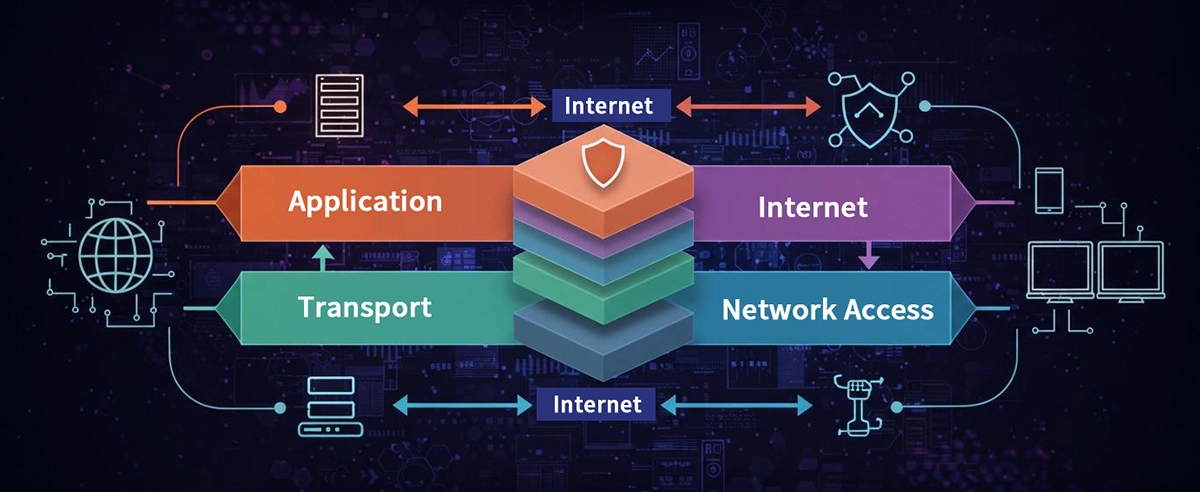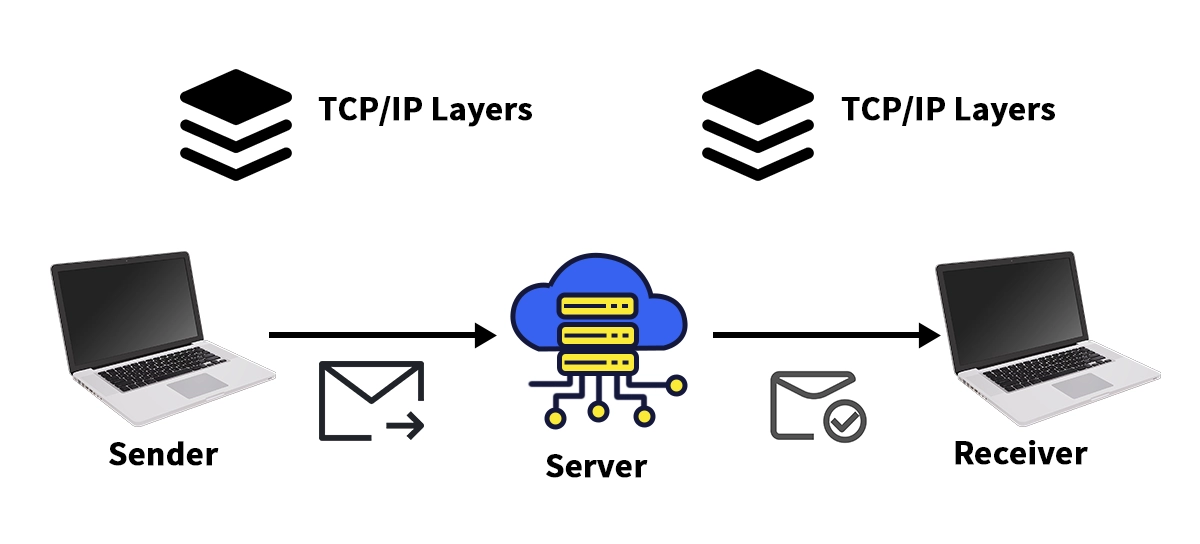
Have you ever wondered how an email seamlessly travels from your device to a colleague on the other side of the world in seconds? Or how you can stream a video without a glitch? The magic behind this digital miracle is a robust, layered framework known as the TCP/IP model. Often called the "internet protocol suite," this model is the fundamental architecture that governs all modern network communication.
In this comprehensive guide, we'll peel back the layers of the TCP/IP model, explore its core functions, and explain why it's non-negotiable knowledge for IT professionals and tech enthusiasts alike. We'll also dive into the physical hardware that brings this model to life, including a look at high-performance optical transceivers, and how brands like LINK-PP are pushing the boundaries of speed and reliability. Ready to become a networking pro? Let's begin!
🚀 Key Takeaways
The TCP/IP model is very important for internet communication. It shows how devices send and get data safely.
It has four layers: Application, Transport, Internet, and Network Access. Each layer has a special job in moving data.
TCP makes sure data gets delivered without mistakes. It checks for errors and sends lost packets again. IP sends packets to the right places.
Learning about the TCP/IP model helps you see how online things work. This includes browsing the web and sending emails.
Many devices and networks use this model. It is a key part of today’s technology.
🚀 What Exactly is the TCP/IP Model?
The TCP/IP model is a concise, practical framework that standardizes how data is transmitted across networks, including the global internet. Unlike the more theoretical 7-layer OSI model, TCP/IP uses a streamlined 4-layer approach that has been proven in the real world. Its name comes from its two most foundational protocols: the Transmission Control Protocol (TCP) and the Internet Protocol (IP).
Developed in the 1970s by the U.S. Department of Defense, its design prioritizes resilience and the ability to maintain communication even if parts of the network fail. This "end-to-end" principle is why the internet is so robust today. Understanding the TCP/IP protocol suite is the first step in mastering network fundamentals and troubleshooting complex connectivity issues.

🚀 The 4 Layers of the TCP/IP Model: A Deep Dive
Each layer in the TCP/IP stack has a specific job, working in harmony with the layers above and below it. Data starts at the application layer and moves down, getting wrapped in headers at each step—a process known as encapsulation. When it reaches its destination, the data moves back up the layers, with each layer stripping off its respective header.
The following table provides a clear, at-a-glance overview of the four layers, their key protocols, and primary functions—a crucial reference for anyone looking to understand TCP/IP layers.
TCP/IP Layer | Key Protocols & Technologies | Primary Function | Analogy |
|---|---|---|---|
4. Application Layer | HTTP, HTTPS, FTP, SMTP, DNS | Provides network services directly to user applications. This is the interface for human-computer interaction. | Writing a letter (the data) and putting it in an envelope. |
3. Transport Layer | TCP, UDP | Ensures end-to-end communication, data integrity, and error recovery. TCP is connection-oriented and reliable; UDP is fast and connectionless. | Choosing a postal service: registered mail (TCP) vs. standard mail (UDP). |
2. Internet Layer | IP (IPv4/IPv6), ICMP, ARP | Handles the routing of packets across different networks. It assigns logical addresses (IP addresses) and determines the best path for data. | The postal system reading the address on the envelope and routing it between post offices. |
1. Network Access Layer | Ethernet, Wi-Fi, PPP, Fiber Optics | Defines how data is physically sent over the network, including the network interface card (NIC) and the physical medium (cables, radio waves). | The delivery truck and roads that physically transport the letter. |
1. Application Layer: The User Interface
This is the layer that users interact with directly. When you use a web browser, email client, or file transfer app, you're using the application layer. Protocols like HTTP (for web traffic) and SMTP (for email) operate here.
2. Transport Layer: The Reliability Engineer
The transport layer is the traffic controller. TCP establishes a stable connection, breaks data into segments, and reassembles them, ensuring nothing is lost. UDP, used for live video or gaming, sacrifices reliability for raw speed.
3. Internet Layer: The Master Navigator
This is the core of the "internet." The Internet Protocol (IP) is responsible for addressing and routing. It packages data from the transport layer into packets and uses IP addresses to get them to the correct destination network.
4. Network Access Layer: The Physical Workhorse
This bottom layer deals with the hardware. It covers everything from the Ethernet cable plugged into your computer to the wireless signal from your router. It defines how data is formatted into frames and transmitted over the physical medium.
🚀 The Critical Role of Optical Transceivers in the TCP/IP Model
While the TCP/IP model is a logical blueprint, it requires physical hardware to function. This is where the Network Access Layer comes alive, and optical transceivers play a starring role. An optical transceiver, or optical module, is a device that converts electrical signals from a network device into light signals for transmission over fiber optic cables, and vice-versa.
Think of it as the ultimate interpreter between the digital world of your switch/router and the lightning-fast world of light pulses traveling through glass fibers. For the TCP/IP model to achieve high-speed, long-distance data transfer, reliable optical modules are indispensable. They directly impact the performance, latency, and bandwidth of your network infrastructure.
When building or upgrading a data center or enterprise network, choosing the right optical module is a critical network optimization decision. This is where industry leaders like LINK-PP excel. For instance, the LINK-PP SFP28-25G-SR optical module is a high-performance solution designed for 25 Gigabit Ethernet applications, offering exceptional reliability and low power consumption for top-of-rack switching and server connectivity. By integrating high-quality components like this, businesses can ensure their TCP/IP network layers operate at peak efficiency, supporting the massive data demands of modern applications.
🚀 Why is the TCP/IP Model So Important?
The dominance of the TCP/IP model isn't an accident. Its design offers several key advantages that make it perfect for a global, heterogeneous network like the internet:
Interoperability: It allows diverse hardware and software from different vendors to communicate seamlessly.
Scalability: Its decentralized, packet-switched nature allows the internet to grow exponentially.
Reliability: The model is designed to be fault-tolerant, with multiple paths for data to travel.
Foundation for Innovation: It provides a stable base upon which new applications and services (like cloud computing and IoT) can be built.
Understanding this model is essential for effective network troubleshooting and for anyone aiming to design a future-proof enterprise network architecture.
🚀 Conclusion: Mastering the Digital Backbone
The TCP/IP model is more than just a technical concept; it is the very DNA of our connected world. From sending a simple text message to running global cloud infrastructures, every byte of data follows the rules defined by this elegant four-layer suite. By understanding its layers—from the user-facing Application layer down to the hardware-driven Network Access layer—you gain a powerful lens through which to view and solve modern networking challenges.
As networks evolve to handle greater speeds and lower latencies, the physical components, like the high-grade optical modules from LINK-PP, become ever more critical. They are the unsung heroes that empower the logical model to perform in the real world.
🚀 FAQ
What is the main purpose of the TCP/IP model?
You use the TCP/IP model to help devices share information on a network. This model gives you a set of rules that guide how data moves from one device to another.
What devices use the TCP/IP model?
You use the TCP/IP model on computers, phones, tablets, and smart devices. Most modern technology that connects to the internet uses this model.
What happens if a packet gets lost in the TCP/IP model?
TCP checks if all packets arrive. If a packet gets lost, TCP asks for it again. This process helps you get complete and correct data.
Tip: TCP keeps your messages safe by checking for missing packets.
What is an IP address?
An IP address is a unique number for each device on a network. You use it to help data find the right device. Every time you go online, your device uses an IP address.


